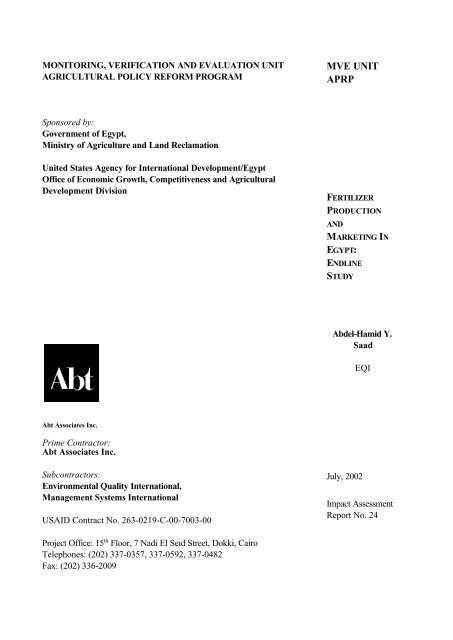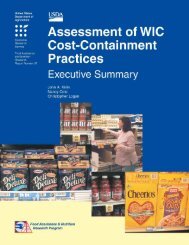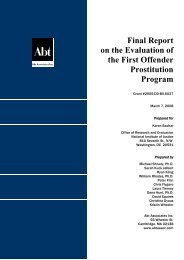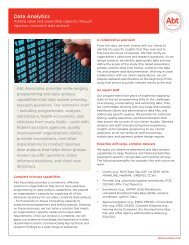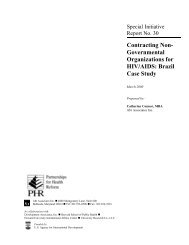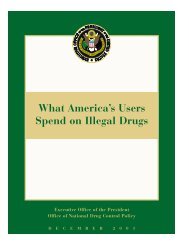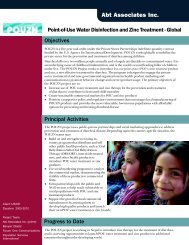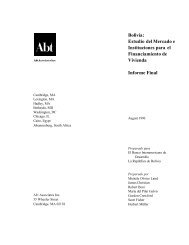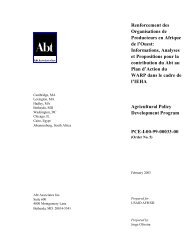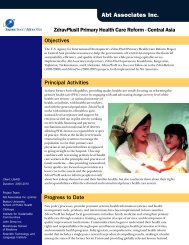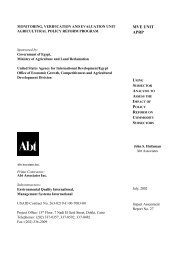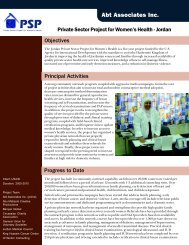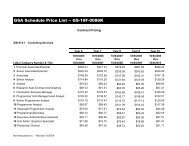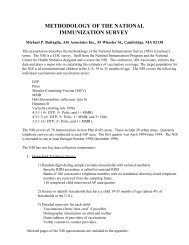Fertilizer Production And Marketing In Egypt ... - Abt Associates
Fertilizer Production And Marketing In Egypt ... - Abt Associates
Fertilizer Production And Marketing In Egypt ... - Abt Associates
You also want an ePaper? Increase the reach of your titles
YUMPU automatically turns print PDFs into web optimized ePapers that Google loves.
MONITORING, VERIFICATION AND EVALUATION UNIT<br />
AGRICULTURAL POLICY REFORM PROGRAM<br />
MVE UNIT<br />
APRP<br />
Sponsored by:<br />
Government of <strong>Egypt</strong>,<br />
Ministry of Agriculture and Land Reclamation<br />
United States Agency for <strong>In</strong>ternational Development/<strong>Egypt</strong><br />
Office of Economic Growth, Competitiveness and Agricultural<br />
Development Division<br />
FERTILIZER<br />
PRODUCTION<br />
AND<br />
MARKETING IN<br />
EGYPT:<br />
ENDLINE<br />
STUDY<br />
Abdel-Hamid Y.<br />
Saad<br />
EQI<br />
<strong>Abt</strong> <strong>Associates</strong> <strong>In</strong>c.<br />
Prime Contractor:<br />
<strong>Abt</strong> <strong>Associates</strong> <strong>In</strong>c.<br />
Subcontractors:<br />
Environmental Quality <strong>In</strong>ternational,<br />
Management Systems <strong>In</strong>ternational<br />
USAID Contract No. 263-0219-C-00-7003-00<br />
July, 2002<br />
Impact Assessment<br />
Report No. 24<br />
Project Office: 15 th Floor, 7 Nadi El Seid Street, Dokki, Cairo<br />
Telephones: (202) 337-0357, 337-0592, 337-0482<br />
Fax: (202) 336-2009
TABLE OF CONTENTS<br />
LIST OF TABLES .......................................................... ii<br />
LIST OF FIGURES ......................................................... ii<br />
ACKNOWLEDGMENTS ....................................................iii<br />
EXECUTIVE SUMMARY ....................................................iv<br />
1. INTRODUCTION ........................................................1<br />
1.1 Brief History of <strong>In</strong>stitutions Distributing <strong>Fertilizer</strong> .........................1<br />
1.2 1995 Crisis ....................................................1<br />
1.3 Role of APRP ..................................................2<br />
2. STRUCTURE ...........................................................3<br />
2.1 <strong>Production</strong> .....................................................3<br />
2.2 Prices ........................................................5<br />
2.3 Distribution ....................................................5<br />
3. CONDUCT ............................................................12<br />
3.1 <strong>Production</strong> ....................................................12<br />
3.2 Distribution ...................................................13<br />
3.3 Farmers’ Preferences for Market Channels ............................14<br />
4. MARKET PERFORMANCE ..............................................16<br />
4.1 Prices .......................................................16<br />
4.2 APRP Contributions .............................................16<br />
4.3 <strong>Fertilizer</strong> Bottlenecks ............................................17<br />
5. CONCLUSIONS AND RECOMMENDATIONS ..............................19<br />
ANNEX .................................................................20
LIST OF TABLES<br />
Table 1: Evolution of Abou Qir's Productive Capacity ................................3<br />
Table 2: Domestic <strong>Production</strong> of Nitrogenous <strong>Fertilizer</strong>, 1995/96 – 2000/2001 ..............4<br />
Table 3: Ex-Factory Prices For Nitrogenous <strong>Fertilizer</strong> ................................5<br />
Table 4: Shares of the Different <strong>Marketing</strong> Channels of N. Nitrogen .....................6<br />
Table 5: Prices Paid by Farmers for N. <strong>Fertilizer</strong> May 2002 ............................9<br />
Table 6: Farmer's Opinions about Best Source for Chemical <strong>Fertilizer</strong> by Crop Grown .......10<br />
Table 7: Changes in Farmer’s Opinions Preferences about the Best Source of Chemical <strong>Fertilizer</strong>,<br />
1997-2001 .........................................................10<br />
Table 8: Farmers' Freedom to Choose Their Source of <strong>Fertilizer</strong> .......................11<br />
Table 9: Prices of Nitrogen 46.5 % <strong>Fertilizer</strong> by Supplier, 1997 and 2001 .................16<br />
Table 10: Domestic and World Prices of Urea , and Nominal Protection Coefficient,<br />
1995-2001 .........................................................17<br />
LIST OF FIGURES<br />
Figure 1: Distribution of Nitrogen Chemical <strong>Fertilizer</strong>, 1999-2000 ........................7<br />
Figure 2: Distribution of Nitrogen Chemical <strong>Fertilizer</strong>, March, 2002 .......................8<br />
ii
ACKNOWLEDGMENTS<br />
Thanks and appreciation are due to Dr. Hamid Houdhoud, of the University of Mansoura and Mr.<br />
Refaat El-Sherif of the Supreme Council of Chemical <strong>Fertilizer</strong>, Ministry of Public Enterprises, for the<br />
great help and assistance in providing the data required for this study. It was not possible to complete<br />
this study without the help of these two persons.<br />
Any errors or omissions are the responsibility of the author and the MVE unit, and not of USAID.<br />
iii
EXECUTIVE SUMMARY<br />
<strong>In</strong> 1998, the MVE Unit carried out a baseline study of the structure, conduct and performance of the<br />
fertilizer subsector. The present study identifies changes that have occurred since the baseline study,<br />
assesses the impact of the APRP benchmarks, and recommends policy actions to improve subsector<br />
performance.<br />
During the period from 1996 to 2001, the structure of the companies producing nitrogen chemical<br />
fertilizer did not change much. Only Talkha company was split into two separate companies in 1998,<br />
increasing the number of producing companies from four to five. However, the total production of<br />
nitrogenous fertilizer increased during the same period from 6.7 million tons (15.5 % N. equivalent) to<br />
8.4 million tons, an increase of 25.6 percent. This increase was due mainly to the opening of Abou Qir<br />
III in 1998 with a capacity of 2000 tons per day. It is expected that Abou Qir IV will start operation<br />
in 2004, with a capacity of 2400 tons per day. Therefore, the total production of nitrogenous fertilizer<br />
of the <strong>Egypt</strong>ian factories is expected to reach 9.9 million tons (15.5 % N. equivalent) by 2005. This will<br />
exceed the local demand for fertilizer, which is estimated at 7.0 million tons, leaving a surplus for export.<br />
<strong>In</strong> the early years of APRP, there were some differences in the quality of fertilizer among the producing<br />
factories, with Abou Qir known for the best quality. However, all the factories now use conditioning<br />
materials to make fertilizer more storable, and the quality currently is very similar. Each factory is<br />
producing at its capacity. Seasonal fertilizer production is relatively stable as compared with seasonality<br />
of demand. Monthly fluctuations in production are due mainly to scheduled repairs and maintenance.<br />
Ex-factory prices of nitrogenous fertilizer are approved by the Government. Any price increase is<br />
requested by the price leading company (Abou Qir), as a result of an increase in its cost of production,<br />
and is generally approved. During the APRP period, the ex-factory prices of nitrogenous chemical<br />
fertilizer showed very little change. The price of urea increased by 6.7%, while the price of ammonium<br />
nitrate increased by 11.1%. On the contrary, the international prices for these fertilizers fluctuated in<br />
the Black Sea market between $170.93/ton of urea in January1996 to $65.60/ton in January 1999,<br />
reaching $101.16/ton at the end of 2001.<br />
PBDAC, the agricultural cooperatives, and the private traders continue to participate in the distribution<br />
of chemical fertilizer. The share of each participant is determined by the Government. There are about<br />
27 big traders (distributors) who deal directly with the producing factories within the quota determined<br />
for the private sector by the Government. The quota for each distributor is determined according to his<br />
past transactions with the factories. Any trader will be dropped from the list if he shows any<br />
misbehavior with respect to good storage or selling price range. The number of private traders is about<br />
6,000. About half of them are licensed, while the other half are unlicensed, generally small retailers<br />
located in villages. Wholesalers generally receive their fertilizer from the distributors and sell to retailers.<br />
The <strong>Egypt</strong>ian Association of <strong>Fertilizer</strong> Distributors and Traders has set the rules of the game for its<br />
members (the majority are distributors) to assure appropriate margins and suitable pricing so that the<br />
private traders would not be blamed for misbehavior, as was the case in 1995.<br />
iv
During the 1995 crisis, PBDAC was instructed to handle 100% of the domestic production. This quota<br />
declined to 10% by 1998, with the private traders handling about 70% and 20% left for the<br />
cooperatives. <strong>In</strong> February, 2002, the quota of PBDAC was increased to 30% and then to 50% in<br />
March, 2002. Some persons in authority indicated that this change in policy is due to the increase in<br />
the prices of fertilizer sold by the private traders, and that this policy change is intended to prevent the<br />
misbehavior of private traders who are exporting fertilizer (due to high international prices) without<br />
satisfying local needs. The increase in the PBDAC quota resulted in a reduction in the quota of the<br />
private traders from 70 % to 50 % and then to 30%. <strong>In</strong>vestigations of the retail prices of fertilizer at<br />
different locations indicated that the prices of the private sales are not much different from those of<br />
PBDAC and the cooperatives. This means that the policy was not based on accurate information about<br />
the fertilizer market. Such a rapid change in distribution policy will have a negative impact (great losses)<br />
on private distributors and traders, who have high fixed and operational costs to handle this large<br />
volume.<br />
With respect to market conduct, it can be said that there are no collusive actions among the producing<br />
companies, neither in the volume of production nor in the pricing of fertilizer products. With an assured<br />
domestic and international demand for nitrogenous fertilizer, each factory is operating at its maximum<br />
capacity. The production technology is well known to each factory, and the ex-factory prices are<br />
approved by the Government, with no options for any factory to change the price.<br />
<strong>In</strong> distribution, the large number of private traders, in addition to the cooperatives and PBDAC,<br />
generally results in competition among them. The quality of the product is determined by the producing<br />
factories, and the ex-factory prices are approved by the Government, with marketing margins<br />
determined by the <strong>Egypt</strong>ian Association for Chemical <strong>Fertilizer</strong> Distributors and Traders. Thus the only<br />
aspects in which the suppliers can compete are in the form of good storage to preserve the quality of<br />
the product, supplying the appropriate combinations of the different fertilizer, and selling on credit. <strong>In</strong><br />
a survey by MVE in 2001, it was found that farmers indicated that the best source for obtaining<br />
chemical fertilizer for the different field crops are private traders (33.4% - 51.9% of the farmers) and<br />
the cooperatives (33.6% - 51.2% of the farmers), while only 0.7% - 1.4% of the farmers preferred<br />
PBDAC. This means that the changes in the distribution policy are against the preferences of the<br />
farmers. This also indicates the necessity of establishing a system for the collection, analysis, and<br />
dissemination of all data related to the production, prices, and distribution of chemical fertilizer.<br />
An examination of the Nominal Protection Coefficient (NPC) indicates that the increase in the domestic<br />
price of urea amounted to 11.1%, while the Black Sea market price for urea increased by 238.5%<br />
between 1999 and 2001. The relative stability of the domestic price and the fluctuating international<br />
price affected tremendously the Nominal Protection Coefficient (NPC). Therefore, there was implicit<br />
taxation in some years and implicit subsidy in some other years.<br />
Even though changes in policy toward chemical fertilizer were not a major thrust of APRP, the project<br />
did play a role in reducing the role of the public sector and subsidized companies, and increasing the<br />
role of private traders. These steps included:<br />
v
• The design and implementation of policy benchmarks aimed at increasing the role of the private<br />
sector in production and in marketing, in order to increase competition and improve<br />
performance.<br />
• Organization of several meetings with producers, distributors and leading members of the<br />
<strong>Egypt</strong>ian Association of <strong>Fertilizer</strong> Distributors and Traders to discuss the problems and issues<br />
that they face in the production, pricing, and distribution of fertilizer. The proposals and the<br />
outcomes of these meetings were conveyed to policy makers.<br />
vi
1. INTRODUCTION<br />
1.1 Brief History of <strong>In</strong>stitutions Distributing <strong>Fertilizer</strong><br />
Since the <strong>Egypt</strong>ian revolution in 1952, the <strong>Egypt</strong>ian Government used the so-called agricultural<br />
cooperatives (actually they were, and still are, government entities) as the single channel for distributing<br />
new forms of farm inputs (mainly chemical fertilizer, improved seed of strategic crops, insecticides, etc.)<br />
in addition to the assembly of the forced deliveries of agricultural commodities. By the mid 1970s for<br />
unknown reasons, these so-called agricultural cooperatives were liquidated, and some of the facilities<br />
(especially storage) were transferred to the newly born Principal Bank for Development and<br />
Agricultural Credit (PBDAC) with branches established in nearly all the villages of <strong>Egypt</strong>. PBDAC<br />
took over the monopolistic role played previously by the agricultural copperatives.<br />
Based on the Economic Reform and Structural Adjustment Program (ERSAP) that started in 1990/91,<br />
government policy was directed toward the transformation of the different public sector enterprises,<br />
including PBDAC, along commercial lines and to more of a free market structure. The increased<br />
participation of the private sector in the production and distribution of new farm inputs were expected<br />
to increase competition and the efficiency of the market system. PBDAC was required to operate like<br />
a commercial bank in the business of savings and credit bank. During the period from 1990 to 1994,<br />
the role of PBDAC in the distribution of chemical fertilizer declined gradually from complete<br />
monopolization to handling of only 10 % of domestic production of nitrogenous fertilizer. The role of<br />
the private sector increased that it distributed about 70 % of domestic production in 1994.<br />
1.2 1995 Crisis<br />
<strong>In</strong> the period of the peak demand for the nitrogenous fertilizer for the summer growing season, a great<br />
shortage accompanied were a great increase in the prices of these fertilizer. The main reasons for this<br />
crisis were:<br />
• Breakdowns in the production units of the Talkha factory.<br />
• Repairs and maintenance for units of the Abou Qir factory.<br />
• <strong>In</strong>creased exports of fertilizer as a result of high world prices.<br />
The two companies mentioned above produce over 90 % of nitrogenous fertilizer which exaggerated<br />
the problem. The private sector was blamed for the creation of the crisis, and the Government of <strong>Egypt</strong><br />
(GOE) took the following actions to alleviate the problem:<br />
• PBDAC was instructed to handle all the domestic production of nitrogenous fertilizer.<br />
• The private sector was asked to import 1.25 million tons (15.5 % N. equivalent) duty-free.<br />
• The 30 % duty on the importation of nitrogenous fertilizer was temporarily canceled.<br />
By the time the repairs and maintenance were completed at the two big companies the private sector<br />
imported the assigned amount, the peak season for demand for the nitrogenous fertilizer was over, and<br />
the fertilizer started to pile up in the poor storage facilities of PBDAC, which asked the government
to reduce its share of domestic production. Since early 1997, the share of PBDAC has decreased and<br />
the share of the private sector increased again.<br />
Looking more broadly at the production of all chemical fertilizer, there has been some privatization of<br />
the public sector companies since the mid 1990s. Before 1996, all factories producing fertilizer were<br />
all under public sector management. Currently, the production of phosphorus chemical fertilizer is 100<br />
% under the management of the private sector. About 75 % of nitrogen fertilizer production is now<br />
in companies organized under the private sector law 1 *. Even though there are no barriers to limit the<br />
private sector in the production of chemical fertilizer, private investors find it easier to buy public sector<br />
companies instead of establishing new ones. Therefore, the number of producing factories changed ver<br />
little during the period of the APRP.<br />
1.3 Role of APRP<br />
APRP started after the 1995 crisis, when the fertilizer market was highly disturbed and PBDAC was<br />
controlling the major part of the domestic distribution of fertilizer. The private traders were suffering<br />
from the unstability of the market caused by the unclear policy of the GOE with regard to the fertilizer<br />
market. Consequently, APRP designed a number of benchmarks to improve the operation and<br />
performance of the fertilizer market. Among the different benchmarks were those related to fertilizer:<br />
Tranche I:<br />
I.B.1. Reduce the tariff on nitrogen fertilizer ( ammonium nitrate and urea) from 30 % to 10% .<br />
I.B.2. Review ex-factory prices and set them in light of border prices, adjusting the prices at least<br />
once per season. The definition of border prices will be according to the monitoring plan.<br />
I.B.3. Eliminate government quota allocations of fertilizer, except in the case of market failure.<br />
I.B.4. Based on the study of fertilizer production to be completed by February, 1996, the GOE will<br />
adopt a time phased liberalization and privatization to fertilizer production, marketing and<br />
<strong>In</strong>ternational Trade.<br />
I.B.5. Privatize one fertilizer plant by September 1996.<br />
Tranche II:<br />
A3. GOE will issue instructions to fertilizer factories to sell fertilizer without quotas for any group<br />
under commercial conditions and will develop an overall fertilizer policy framework emphasizing<br />
fertilizer production, pricing trade and private sector participation.<br />
1 Abu Qir is owned by the public sector but organized under Law 159 for private companies.<br />
2
2. STRUCTURE<br />
2.1 <strong>Production</strong><br />
<strong>In</strong> 1996, there were four companies producing nitrogenous fertilizer. By 1998, they became five<br />
companies. This was due to the division of Talkha company (El-Nasr Company for <strong>Fertilizer</strong> and<br />
Chemical <strong>In</strong>dustries) into two units, one under the same name, for the production of ammonium sulfate<br />
and nitrolin, while the other unit was renamed “El-Delta Company for <strong>Fertilizer</strong> and Chemical<br />
<strong>In</strong>dustries”, and specialized in the production of urea and ammonium nitrate. During the same period,<br />
Abou Qir Co. expanded its operation by establishment of Abou Qir III, which started in production<br />
in 1998. The company has have plans for more expansion in Abou Qir IV, as indicated in Table 1.<br />
Productive Units<br />
Abou Qir I<br />
Ammonia Unit<br />
Urea Unit<br />
Table 1: Evolution of Abou Qir's Productive Capacity<br />
1100<br />
1550<br />
Capacity<br />
(Tons/day)<br />
Ammonia<br />
Urea<br />
3<br />
Products<br />
Begining of<br />
Operation<br />
September 1979<br />
Marine Line 100,000 tons/year Excess Ammonia December 1990<br />
Abou Qir II<br />
Ammonia Unit 1000<br />
Ammonia<br />
Acid Unit<br />
1800<br />
Nitric acid<br />
Nitrate Unit<br />
2400<br />
Ammonium nitrate<br />
August 1991<br />
Abou Qir III<br />
Ammonia Unit<br />
Special Urea Unit<br />
Abou Qir IV<br />
Ammonia Unit<br />
Nitric Acid Unit<br />
Ammonium Nitrate<br />
Unit*<br />
Calcium Nitrate<br />
1200<br />
2000<br />
1200<br />
1800<br />
2400<br />
Ammonia<br />
Urea<br />
Ammonia<br />
Nitric acid<br />
Ammonium nitrate<br />
October1998<br />
Expected second half<br />
of 2004<br />
Source: Abu Qir Company for <strong>Fertilizer</strong> and Chemical <strong>In</strong>dustry, Annual Report 2000/01, 25 th Anniversary.<br />
*Ammonium nitrate unit will be composed of two lines each with capacity of 1200 tons / day. One of these lines will<br />
be equipped to produce calcium ammonium nitrate according to demand, in addition to the ammonium nitrate.<br />
Nitrogen fertilizer production during the APRP period increased from 7.1 million tons (15.5% N.<br />
equivalent) of the different nitrogen fertilizer in 1995/1996 to 8.8 million tons in 2000/2001, as<br />
presented in Table-2.<br />
The increase in the production of nitrogenous fertilizer during the period 1995/96 to 2000/2001 is due<br />
to the establishment of Abou Qir III, which started production in 1998, with productive capacity of
600,000 tons/year of urea. Abou Qir IV is planned to start production in 2005 as a (free zone unit),<br />
with productive capacity of 600 tons / year of ammonium nitrate. If Abou Qir IV is completed, the total<br />
nitrogenous fertilizer produced by the Abou Qir Complex will reach 7.0 million tons (15.5 % N<br />
equivalent). The <strong>Egypt</strong>ian Factory for Chemical <strong>Fertilizer</strong> is under establishment at Ain Sukhna in Suez<br />
governorat , as a private (free zone unit) by SAMAD MISR COMPANY, which will further add to<br />
the productive capacity of nitrogenous fertilizer.<br />
4
Table 2: Domestic <strong>Production</strong> of Nitrogenous <strong>Fertilizer</strong>, 1995/96 – 2000/2001<br />
(000 tons, 15.5 % N.)<br />
Company &<strong>Fertilizer</strong> 1995/96 1996/97 1997/98 1998/99 1999/20 2000/2001<br />
Abou Qir<br />
Urea 46.5% 1750.2 1566 1653 2643.3 3633 3635<br />
Ammonium Nitrate 1736.4 1793 1670.7 1772.0 1707.9 1831<br />
33.5%<br />
SubTotal 3486.6 3359 3323.7 4415.3 5340.9 5466<br />
Talkha<br />
Urea46.5% 1539 1558.2 1268.4 0 0 0<br />
Ammonium Nitrate 934.3 930.0 800.1 0 0 0<br />
33.5%<br />
Ammonium<br />
81.5 105.1 65.1 68.2 100.5 84.5<br />
Sulfate20.6%<br />
Nitrolin 33.5% 0 0 0 291.1 385.1 344.1<br />
Sub Total 2554.8 2593.3 2133.6 359.3 485.6 428.6<br />
El-Delta<br />
Urea 46.5% 0 0 0 1221 1317 1501.8<br />
Ammonium Nitrate 33.5% 0 0 509.2 524.1 527.1<br />
Sub Total 0 0 0 1730.2 1841.113 2028.9<br />
El-Cook<br />
Ammonium Nitrate 88.4 88.0 73.9 39.6 15.1 0<br />
33.5%<br />
Ammonium<br />
21.7 21.4 21.1 16.7 13.2 15.9<br />
Sulfate20.6%<br />
Sub Total 110.1 109.4 95.0 56.3 28.3 15.9<br />
Suez<br />
Ammonium Nitrate 308.0 324.0 283.1 291.1 385.1 344.1<br />
33.5%<br />
Ammonium<br />
81.3 105.0 65.1 68.2 100.7 84.5<br />
Sulfate20.6%<br />
Sub Total 389.3 429.0 348.3 359.3 485.9 428.6<br />
Qima<br />
Ammonium Nitrate 595.9 608.8 580.3 560.2 463.6 441.3<br />
33.5%<br />
Sub Total 595.9 608.8 580.3 560.2 463.6 441.3<br />
Total 7136.7 7099.8 6480.9 7480.6 8645.4 8808.94<br />
Source: Ministry of Public Enterprises, Supreme Council of Chemical <strong>Fertilizer</strong>, unpublished data.<br />
5
2.2 Prices<br />
Ex-factory prices for the different chemical fertilizer are shown in table3. There were few changes in<br />
these prices during the period under investigation, amounting to 11.1 % in the case of Abou Qir urea<br />
and only 6.7 % in the case of Abou Qir ammonium nitrate. Comparing these changes with the changes<br />
in the international price of urea in the Black Sea market during the same period indicates that the<br />
international price fluctuated between $170.93/ton in January 1996 to $ 65.60 /ton in January 1999,<br />
a decrease of 61.6%. Seasonal fertilizer production is relatively stable as compared with seasonality<br />
of demand. Monthly fluctuations in production are mainly due to scheduled repairs and maintenance<br />
of the different factories.<br />
Table 3: Ex-Factory Prices For Nitrogenous <strong>Fertilizer</strong><br />
(LE/ton)<br />
Company and <strong>Fertilizer</strong> 1995/96 1996/97 1997/98 1998/99 1999/20 2000/2001<br />
Abou Qir Co. :<br />
Urea 46.5% 450 495 495 495 495 450<br />
Ammonium Nitrate 3.5% 375 399 399 399 399 399<br />
Talkha Co.:<br />
Urea 46.5% 450 450 495 495 410 420<br />
Ammonium Nitrate33.5% 350 380 380 380 365 365<br />
Ammonium Sulfate 20.6% 360 360 360 360 295 340<br />
Nitrolin 33.5% 380 399 399 399 375 380<br />
Source: Ministry of Public Enterprises, Supreme Council of Chemical <strong>Fertilizer</strong>, unpublished data.<br />
Due to the great seasonality of demand for nitrogen fertilizer and the relative seasonal stability of<br />
production, the baseline study proposed certain discounts to be offered by the producing factories to<br />
the distributors sufficiently large to cover storage costs in order to stabilize the distributors' withdrawal<br />
of the fertilizer stocks from the factories. However, no price discounts have been made. It seems that<br />
the factories have no problem with their stocks. During the domestic peak demand, the factories offer<br />
their output to the local distributors. During the off-season period, the factories find it more profitable<br />
to export their output instead of offering discounts to domestic distributors. By 1998, with the operation<br />
of Abou Qir III, domestic production became large enough to meet domestic production during the<br />
peak season . Lower off-season prices have never been offered.<br />
2.3 Distribution<br />
PBDAC, the agricultural cooperatives, and the private sector participated in the distribution of fertilizer<br />
during the last fifteen years. Their shares are indicated in Table 4. and Figures 1 and 2.<br />
Private traders entered fertilizer distribution early in the 1990s. Their number is now estimated at 6000.<br />
Nearly half of them are licensed; while the other half are mainly retailers in villages who deal in small<br />
quantities. According to the size of their activities, they can be classified into three groups:<br />
• Distributors, who deal directly with the factories.<br />
• Wholesalers, who receive the fertilizer from distributors and deliver it to retailers.<br />
6
• Distributors and wholesalers are mainly located in the big cities or big towns<br />
• Retailers, who receive fertilizer from wholesalers and sell it to farmers. (Retailers are mainly<br />
located in villages close to farmers.)<br />
Table 4: Shares of the Different <strong>Marketing</strong> Channels of Nitrogen <strong>Fertilizer</strong><br />
(Percent)<br />
Year Domestic Sales PBDAC Cooperatives Private<br />
Sector<br />
1995/96 6529 89 2 6<br />
1996/97 6484 59 19 21<br />
1997/98 5428 20 21 54<br />
1998/99 5975 9 15 75<br />
1999/20 6386 9 13 77<br />
2000/2001 6980 11 19 69<br />
February 2002 N.A. 30 20 50<br />
March 2002 N.A. 50 20 30<br />
Sources: 2002: MALR, Ministerial Decrees No. 303 and 413 for the year 2002. 199596-2000/01: Ministry of Public<br />
Enterprises, Supreme Council of Chemical <strong>Fertilizer</strong>, unpublished data.<br />
One of the benchmarks of APRP required that “ The GOE will issue instructions to fertilizer<br />
factories to sell fertilizer without quotas for any group under commercial conditions and will<br />
develop an overall fertilizer policy framework emphasizing fertilizer production, pricing trade<br />
and private sector participation”. <strong>In</strong> practice, this did not happen. <strong>In</strong> theory, it is expected that as<br />
the number of traders dealing with the producing factories increases competition among them will<br />
increase, to the benefit of the final user of fertilizer. However, from the practical and operational<br />
accounting point of view, the producing factories prefer to deal with a relatively small number of traders<br />
who handle large quantities of their products. Abou Qir Factory has only 27 private distributors in<br />
addition to PBDAC and about three general agricultural cooperatives who handle all of its products.<br />
The selection of the private traders is based on previous history of transactions of these traders with the<br />
factory. Any distributor will be dropped from the list if he misbehaves in the market. This type of<br />
supervision of the factory over its clients of distributors is expected to lead to competition among<br />
themselves to show good behavior in the market.<br />
During the period from 1995/96 to 1999/2000, the share of PBDAC declined gradually from 89 % of<br />
domestic sales of chemical fertilizer to only 9 % while the share of the private sector increased from 6<br />
% to 77 % and the share of the agricultural cooperatives fluctuated closer to 20%. However, in<br />
February 2002, the GOE issued instructions to the producing factories to increase the share of PBDAC<br />
to 30 % by reducing the share of the private sector to 50 %. Within the following month, new<br />
instructions were issued to increase the share of PBDAC to 50 % while decreasing the share of the<br />
private sector to only 30 %. <strong>In</strong>vestigations were made for the quick change in the GOE policy. The<br />
reasons mentioned include:<br />
• <strong>In</strong>creased exports by the private sector due to increased world prices.<br />
• <strong>In</strong>creased prices paid by farmers.<br />
7
Figure 1: Distribution of Nitrogen Chemical <strong>Fertilizer</strong>, 1999-2000<br />
Imports<br />
Domestic<br />
<strong>Production</strong><br />
1%<br />
Exports<br />
77%<br />
9%<br />
13%<br />
Private Distributers<br />
Wholesalers<br />
PBDAC<br />
Coops<br />
Private Retailers<br />
Farmers-Users<br />
8
Figure 2: Distribution of Nitrogen Chemical <strong>Fertilizer</strong>, March, 2002<br />
Imports<br />
Domestic<br />
<strong>Production</strong><br />
1%<br />
Exports<br />
30%<br />
50%<br />
20%<br />
Private Distributers<br />
Wholesalers<br />
PBDAC<br />
Coops<br />
Private Retailers<br />
Farmers-Users<br />
9
<strong>In</strong> February 2002, the GOE anticipated another fertilizer crisis similar to that of 1995, which led to this<br />
quick change in the policy. However, quick field investigations for prices paid by farmers for fertilizer<br />
in different locations were made during the third week of May 2002, the peak month for the demand<br />
for the nitrogenous fertilizer. The results of these investigations are presented in Table 5.<br />
Table 5: Prices Paid by Farmers for N. <strong>Fertilizer</strong> May 2002<br />
LE/Ton<br />
Location Urea 46.5 % A. Nitrate 33.5 %<br />
Menoufia -Coop 525 (A.Q) 458<br />
Menoufia - Ag. Coop 480 (Talkha) 510<br />
Menoufia - Private (1) (A.Q.) 580 (A.Q.) 500<br />
(Talkha) 560 (Talkha) 500<br />
Menoufia - Private (2) 550 500<br />
Menoufia - Private (3) (Talkha) 560 (A.Q.) 505<br />
Menoufia – PBDAC(4) 467 Suez 467<br />
Menoufia – PBDAC (4) (A.Q.) 516<br />
Dakahlia – PBDAC (6) (A.Q.) 532 (A.Q.) 465<br />
Dakahlia – PBDAC(6) (Talkha) 503<br />
Dakahlia - Agr. Coop (A.Q.) 532 (A.Q.) 470<br />
Tahrir –Private 550 510<br />
Source: Data collected by the author.<br />
(1) Village Begiram, Quesna District<br />
(2) Menouf District<br />
(3) Quesna District<br />
(4) Quesna District<br />
(5) City of Shebin El-Kom<br />
(6) City of Mansoura<br />
The table indicates that the maximum retail price for urea is LE 580/ton in Menoufia governorate. If the<br />
ex-factory price of LE 450/ton is taken into consideration, then the three groups of traders that are<br />
involved in the distribution of chemical fertilizer (Distributors, wholesalers, and retailers) obtain a<br />
maximum of LE130/ton as marketing margin, which represents 28.9 %. Assuming that the margin is<br />
divided equally among the three groups of intermediaries, the marketing margin in total (29%) and per<br />
group (9.7 %) is modest by international standards and is not that big to warrant great precautions and<br />
quick changes in GOE policy. It is clear that the action taken by the GOE was not based on objective<br />
data and sound analysis of the fertilizer market.<br />
This quick change in the policy of the GOE will have adverse effects on the market for fertilizer in the<br />
following ways:<br />
• Great disturbance to the relative stability of the market that existed in the last few years. This<br />
will limit the response of private traders to market signals, which may vary from the intentions<br />
of the policy makers.<br />
10
• Great losses for private traders, who have high fixed and operational costs to handle over 70%<br />
of fertilizer.<br />
• Unfair competition: because PBDAC and the coops are partially subsidized by the<br />
Government, they can realize lower margins than those that would prevail under full cost<br />
pricing.<br />
• Some traders will have to reduce at least some of their operational costs, thus increasing<br />
unemployment, social disturbance and political instability.<br />
Therefore this changing and unclear policy will have a negative impact on producers and distributors<br />
and will affect investments in these activities. On the other hand, the endusers of chemical fertilizer<br />
(farmers) still prefer to buy their fertilizer from private traders and agricultural cooperatives for the<br />
different field crops, as indicated in Table 6.<br />
Table 6: Farmer's Opinions about Best Source for Chemical <strong>Fertilizer</strong> by Crop Grown<br />
(percent)<br />
Suppiers Cotton Wheat Maize Rice<br />
PBDAC 1.2 1.1 1.7 1.4<br />
Cooperatives 52.2 42.8 33.6 37.5<br />
Private Traders 33.4 44.3 41.6 51.9<br />
Others 13.2 11.8 24.1 9.2<br />
Total 100.0 100.0 100.0 100.0<br />
Source : Source: Morsy Aly Fawzy et al. The Impact of APRP at the Farm Level, MVE/APRP Impact Assessment<br />
Report No.28, July 2002.<br />
The table indicates that the best sources for fertilizer for the different field crops are the private traders<br />
and agricultural cooperatives. PBDAC is considered a best source for fertilizer by a very limited<br />
number of farmers. Table.7 indicates that during the APRP period, the preference of farmers to buy<br />
fertilizer from PBDAC has declined tremendously, so that there is practically no preference for dealing<br />
with PBDAC in the purchase of chemical fertilizer. This is an indication that the change in the policy<br />
is against the farmers’ preferences who are currently free to buy their fertilizer from any supplier (See<br />
Table 8.).<br />
11
Table 7: Changes in Farmer’s Opinions Preferences about the Best Source of Chemical<br />
<strong>Fertilizer</strong>, 1997-2001<br />
(percent)<br />
Suppliers 1997 2001 Difference<br />
PBDAC 29 1 28<br />
Cooperatives 46 42 4<br />
Private Traders 16 43 27<br />
Others 9 14 5<br />
Total 100 100 100<br />
Source: Morsy Aly Fawzy et al. The Impact of APRP at the Farm Level, MVE/APRP Impact Assessment Report<br />
No.28, July 2002.<br />
Cotton<br />
Wheat<br />
Maize<br />
Rice<br />
Table 8: Farmers' Freedom to Choose Their Source of <strong>Fertilizer</strong><br />
(percent)<br />
Crop Free Not Free<br />
98<br />
100<br />
100<br />
100<br />
Source: Morsy Aly Fawzy et al. The Impact of APRP at the Farm Level, MVE/APRP Impact Assessment Report<br />
No.28, July 2002.<br />
2<br />
0<br />
0<br />
0<br />
12
3. CONDUCT<br />
Market conduct means the behavior of all the participants in the market, particularly those aspects of<br />
behavior that suggest restraint of trade or competition or that fail to provide final users with the quality<br />
and kind of material desired, especially with respect to the production and pricing policies. Normally,<br />
government policies would be considered part of market structure. However, rapid and unpredictable<br />
changing of government policy is the most factor limiting to the rapid evolution of private sector<br />
participation in the fertilizer market in <strong>Egypt</strong>. The best example of the serious interference in the fertilizer<br />
market by the Government was the sudden change in the PBDAC quota twice in two months (February<br />
and March, 2002), at a time when the market was relatively stable and there was no need for that<br />
interference which will result in substantial losses for private dealers, who will experience a sharp<br />
reduction in sales in the face of high fixed and operating costs.<br />
3.1 <strong>Production</strong><br />
<strong>In</strong> the production of chemical fertilizer, it seems that there is no collusive action among the producing<br />
companies. Collusion is when private producers and traders conspire to restrain trade in a way that<br />
increases their own sales and profits. The production of this group of commodities is based on wellknown<br />
chemical formulas whose production technology is very well known to everyone. <strong>In</strong> addition,<br />
domestic and international markets are capable of absorbing all quantities produced. Accordingly each<br />
company is producing the maximum possible quantity determined by its productive capacity. Therefore,<br />
there is no competition with regard to the volume of production of each company. On the other hand,<br />
there seems to be some competition with respect to quality. Prices differ for the same fertilizer<br />
according to the producing company. The products of Abou Qir factory are well known for being of<br />
the highest quality. That is why they are priced and sold to farmers at prices heigher than for similar<br />
products of Talkha or other companies (See Table 3). <strong>In</strong> 1997, the products of Talkha factory were<br />
of very poor quality. Even PBDAC refused to receive its quota from the factory, and great quantities<br />
piled up in the limited storage facilities of the factory. This created great problems for the company and<br />
led to the split of the company into two units, as mentioned before. New management and new technical<br />
staff were appointed for the separate unit called El-Delta Company. The quality of the products of the<br />
new company has been improved and is getting closer to competing with the products of Abou Qir.<br />
So, some competition exists with respect to quality of the products.<br />
The pricing of chemical fertilizer does not represent an issue for competition among producing<br />
companies. Actually, Abou Qir company can be considered a price leader. It requests price increases<br />
when it has increased production costs, especially for the main raw material, natural gas. This request<br />
is reviewed and discussed within the government offices, especially in the Ministry of Public Enterprises<br />
(MPE) and the Ministry of Agriculture and Land Reformation (MALR). <strong>In</strong> most cases, the requested<br />
price increase is approved. Price increases apply to all companies producing chemical fertilizer. <strong>In</strong><br />
the baseline study, it was proposed that producing companies should have greater control over exfactory<br />
prices so they could give discounts sufficiently large to cover storage costs. However, until the<br />
preparation of this endline report, nothing changed and ex-factory prices are relatively stable all year.<br />
The ability of the international market to absorb the surpluses of fertilizer during the off-peakseason<br />
eliminates the need for these companies to offer discounts.<br />
13
Therefore, there are no collusive actions among the producing companies, neither in the volume of<br />
production nor in the pricing of fertilizer products.<br />
3.2 Distribution<br />
<strong>In</strong> distribution, the large number of traders involved in the marketing of chemical fertilizer would, in<br />
theory, induce competition among them. However, the quality of the product is determined mainly by<br />
the producing factory, and there is very little for any trader to improve quality. He can only store<br />
fertilizer in a good place to preserve the quality. <strong>In</strong> addition, the prices of chemical fertilizer are nearly<br />
determined as the ex-factory prices including transportation costs to each specific location. Producing<br />
companies make contracts with cooperatives of truck transport. For this purpose <strong>Egypt</strong> is classified into<br />
three zones, lower <strong>Egypt</strong>, Middle <strong>Egypt</strong>, and upper <strong>Egypt</strong>. The cost of transportation per ton is<br />
determined as an average for each of the three zones and is added to the ex-factory price. Therefore,<br />
the prices paid by the fertilizer distributors are the same in each zone. <strong>Marketing</strong> margins might differ<br />
among traders. To stabilize the operation of the fertilizer market at the top level and to prevent any<br />
misbehavior of any trader similar to that during 1995 crisis, the <strong>Egypt</strong>ian Association of <strong>Fertilizer</strong><br />
Distributors and Traders (EAFDT) was established just before1996, and became very effective in<br />
2000. The members of this association are the main distributors (about 27) who receive quotas from<br />
the local fertilizer manufacturers, in addition to exporting or importing fertilizer. <strong>In</strong> 2000, the members<br />
of this association set “rules and regulations of the game” for the operation of their firms in fertilizer<br />
trading. The system now operates like a centralized cartel. The main approved rules for the operation<br />
are as follows:<br />
• <strong>In</strong> coordination with the fertilizer factories, and based on the total quota assigned to the private<br />
sector out of the domestic production, each firm has been assigned a specific quota from each<br />
factory and of each type of fertilizer. These personal quotas have been agreed upon by each<br />
member of the association.<br />
• Transportation cost from the factory to the distributors’ yards is fixed and is determined as<br />
mentioned before.<br />
• 3% margin has been determined and agreed upon by the members of the association. As long<br />
as these firms receive fertilizer at the same ex-factory price, and as long as they charge the<br />
same margin, the selling price is the same for the same product among all sellers in the same<br />
zone.<br />
• Each factory submits to the association a monthly list of the different quantities delivered to each<br />
member.<br />
• If any firm in any month would receive more than its personal quota, the margin for the excess<br />
amount is paid to the firm whose quota has been affected in addition to a specific fine/ton to be<br />
paid for the association.<br />
14
• Daily contacts and weekly meetings for the members of the association harmonize the operation<br />
of the association.<br />
This system presents no room for competition among the distributors of chemical fertilizer. While there<br />
is no geographic distribution of the market among the distributors, there is also profitable way for them<br />
to increase their sales. <strong>In</strong> any governorate or district, the branches of a number of distributing<br />
companies might exist. Competition exists, however between wholesalers and retailers in the following<br />
forms:<br />
• Providing the required combinations of the different fertilizer at the appropriate times.<br />
• Providing some services to the buyers like selling on credit.<br />
• Special discounts for cash payments or good reputation of the buyer or volume of purchases.<br />
3.3 Farmers’ Preferences for Market Channels<br />
The preferences of farmers for the purchase of fertilizer are based on several factors, as indicated in<br />
Tables A-1 to A-4 in the Annex. The tables indicate that the main reasons for buying from a specific<br />
supplier are:<br />
• Availability of the fertilizer at all times<br />
• Lower Price<br />
• Better Facilities<br />
• Contract with the company<br />
• A combination of all these factors<br />
The tables also indicate that in the case of cotton growers, the cooperatives rank first, followed by<br />
private traders, while PBDAC ranks last. <strong>In</strong> the case of wheat, maize and rice, private traders rank first,<br />
followed by the coops, PBDAC ranks last. Apparently PBDAC does not offer any reason for the<br />
farmers to buy fertilizer from it. With the exception of cotton, the private traders are preferred to other<br />
sources. The rapid and unpredictable changes in the government policy related to the determination of<br />
specific quotas for the different fertilizer marketing channels, (that is against the will and the preference<br />
of the end users of the fertilizer), which has been mentioned before, is the most significant impediment<br />
to a more rapid evolution of competitive private sector participation in the fertilizer market in <strong>Egypt</strong>.<br />
The baseline report proposed free ex-factory sales to any trader without determination of special<br />
allocations to political favorites. An example of such favortisim, is the increase in the quota allocated<br />
to PBDAC in February and March 2002. <strong>In</strong> addition PBDAC refused to pay the same ex-factory price<br />
for fertilizer as the private traders. <strong>In</strong> January 2002, Abou Qir Company raised the price of urea by<br />
LE 5 per ton and the price of ammonium nitrate by LE 10 per ton. This increase was applied to all the<br />
clients of Abou Qir with the exception of PBDAC, which insisted on paying the old price for its<br />
purchases. This decision is not made by the companies but by government policy. This favoritism was<br />
expected to be obsolete after the 1998 production season with increased domestic production.<br />
The baseline report also indicated that the 30-percent import duty creates a gap between import and<br />
export parity equal to the duty plus international transportation costs and proposed the reduction of that<br />
15
duty to 0-10 percent and an anti-dumping levy of the difference between 20 percent or 30 percent and<br />
the new duty. Until the preparation of this endline report, the import duty on nitrogen fertilizer is still 30<br />
percent.<br />
To strengthen the agricultural cooperatives, the baseline report proposed that the GOE may require<br />
PBDAC to return to the cooperatives the storage facilities that were transferred to PBDAC from the<br />
cooperatives in 1976. However, the storage facilities are still under the management of PBDAC.<br />
A fertilizer information system was proposed in the baseline study to assist companies and the<br />
Government in anticipating and responding to market signals. Such a system would collect and analyze<br />
quantitative data on fertilizer production, domestic deliveries, imports, exports, inventories, prices,<br />
consumption, and international prices. The <strong>Egypt</strong>ian <strong>Fertilizer</strong> Development Center would provide an<br />
appropriate structure if it were completely independent of Talkha company. However, the situation is<br />
still as it was at the time of the baseline report with no development of an accurate information system.<br />
The best indication of that is the explanation given by people in authority explaining the reason behind<br />
the increase in the PBDAC quota (and accompanying discussion high prices of private sales), which<br />
was proved to be completely wrong (see Table 5).<br />
16
4. MARKET PERFORMANCE<br />
4.1 Prices<br />
During the APRP period, the market for chemical fertilizer was relatively stable, with prices showing<br />
very little as indicated in Table 9.<br />
PBDAC<br />
Cooperatives<br />
Private Traders<br />
Table 9: Prices of Urea by Supplier, 1997 and 2001<br />
(LE per 50 kg)<br />
Supplier 1997 2001 Difference (%)<br />
27.0<br />
27.9<br />
29.0<br />
17<br />
27.3<br />
27.2<br />
28.6<br />
1.1<br />
-2.5<br />
-1.4<br />
Source: Morsy Aly Fawzy et al. The Impact of APRP at the Farm Level, MVE/APRP Impact Assessment Report<br />
No.28, July 2002.<br />
The price of urea supplied by PBDAC showed little increase while the price of urea supplied by<br />
cooperatives and private traders showed some decline, indicating more efficient operation of the last<br />
two suppliers in the marketing of chemical fertilizer.<br />
The nominal Protection Coefficient (NPC) shows the extent of protection of local production Table 10<br />
shows the domestic price of Abou Qir urea and the world price of Urea in the Black Sea market c.i.f.<br />
Alexandria. The NPC is defined as the ratio of domestic f.o.b. price to the border or c.i.f. price for a<br />
domestically produced commodity. It is clear from the table that the change in the domestic price during<br />
the period under study did not exceed 11.1 percent, while the world price decreased by 59.4 percent<br />
from 1995 to 1999, but, increased by 238.5 percent from 1999 to 2001. This relative stability of<br />
domestic prices and the highly fluctuating world prices severely affected the NPC. The domestic price<br />
was higher than import parity for the years 1997, 1998, and 1999, but was much lower during the<br />
remaining years under study. Therefore, there was implicit taxation in some years and implicit subsidy<br />
in the other years. Again, this indicates the necessity of reviewing the policy of the GOE in keeping the<br />
ex-factory prices for chemical fertilizer relatively stable. The prices of the majority of farm outputs (with<br />
the exception of sugar cane) have been left to market forces for determination, and they have been free<br />
to move upward with world prices. Allowing chemical fertilizer prices to fluctuate with crop prices<br />
would stabilize aggregate farm income in most cases better than holding one of the two prices relatively<br />
fixed while freeing the other to move in response to market forces.<br />
4.2 APRP Contributions<br />
Even though changes in policy toward chemical fertilizer were not a major thrust of APRP, the<br />
project did play a role in reducing the role of the public sector and subsidized companies and<br />
increasing the role of private traders. These steps included:<br />
• The design and implementation of policy benchmarks aimed at increasing the role of the<br />
private sector in production and in marketing, in order to increase competition and improve<br />
performance.
Table 10: Domestic and World Prices of Urea , and Nominal Protection Coefficient, 1995-<br />
2001<br />
(LE/ton)<br />
Year Domestic Price* World Price** NPC<br />
1995 450 716 0.63<br />
1996 495 670 0.74<br />
1997 495 467 1.06<br />
1998 495 352 1.41<br />
1999 450 291 1.55<br />
2000 450 484 0.93<br />
2001 450 985 0.46<br />
Sources : World prices: Green Market, different issues. Domestic prices: Ministry of Public Enterprises, Supreme<br />
Council of Chemical <strong>Fertilizer</strong>, unpublished data.<br />
* Ex-factory, Abou Qir (Alexandria).<br />
** Black Sea, CIF Alexandria(additional $20 per ton).<br />
NB: The exchange rate used was LE 3.4/$ from 1995 to 1999, LE 4.0/$ in 2000, and LE 4.5/$ in 2001.<br />
• Organization of several meetings with producers, distributors and leading members of the <strong>Egypt</strong>ian<br />
Association of <strong>Fertilizer</strong> Distributors and Traders to discuss the problems and issues that they face<br />
in the production, pricing, and distribution of fertilizer. The proposals and the outcomes of these<br />
meetings were conveyed to policy makers.<br />
The fertilizer benchmarks aimed at increasing the role of the private sector in the fertilizer subsector,<br />
especially in distribution. The main objective was to increase competition among producers and traders<br />
in order to provide better and cheaper fertilizer to the farmer-user. The system of operation agreed<br />
upon by the members of EFADT does not satisfy this objective, as it eliminates competition at this level.<br />
However, there was significant competition at the wholesale and retail levels, and the farmers were<br />
apparently very satisfied with the results.<br />
4.3 <strong>Fertilizer</strong> Bottlenecks<br />
Domestic production of nitrogen fertilizer is more than the amount needed by the agricultural sector.<br />
This surplus will increase in the future after the completion of Abou Qir IV and other new factories.<br />
However, bottlenecks occur in the market occasionally due to:<br />
• Fluctuations in international prices vis-a-vis the relative stability of domestic prices.<br />
• Shortages of hard currency available for manufacturers and distributors. Manufacturers need hard<br />
currency to finance the importation of spare parts and other basic requirements for their factories.<br />
Distributors need hard currency to import other goods and chemicals they deal with. Even the<br />
public companies, whether manufacturing or trading have been short of hard currency since they<br />
were grouped under Holding Companies and asked to find their own ways to obtain hard currency.<br />
18
Accordingly, when international prices are higher than domestic prices these firms prefer to export<br />
instead of selling locally. This results in a shortage in the local market. When international prices are<br />
lower than domestic prices, exports are discouraged and imports are encouraged 30% duty resulting<br />
in surplus of nitrogen fertilizer in the local market one of the main solutions to this problem is to adjust<br />
local prices of nitrogen periodically to match the international prices.<br />
It should be kept in mind that the different fertilizer benchmarks aimed at increasing the role of the<br />
private sector in the fertilizer sub-sector whether in production or distribution in order to realize the main<br />
objective of increasing competition among producers and traders to provide a better and cheaper<br />
fertilizer to the farmer-user. However, this system of operation that is agreed upon by the members of<br />
the EAFDT dos not satisfy this objective as it deletes the competition among producers and among<br />
traders even though it operates to stabilize fertilizer prices.<br />
19
5. CONCLUSIONS AND RECOMMENDATIONS<br />
Without the interference of the GOE, the market for chemical fertilizer seems to function in a relatively<br />
stable manner. However, due to lack of accurate and objective market information and analysis of this<br />
information, government policies caused disturbances in the market, which is expected to have adverse<br />
economic and social effects. Therefore, the following recommendations are essential for the effective<br />
functioning of the fertilizer market:<br />
• Accurate and objective market information (collection, analysis and dissemination) is a necessity<br />
for stable and effective agricultural policy.<br />
• Domestic prices should be adjusted periodically in light of world prices.<br />
• PBDAC should pay the same ex-factory price as other buyers and should be responsible only<br />
for strategic storage, not trade in fertilizer.<br />
• The 30% tariff on the importation of nitrogen fertilizer should be reduced to 0-10 %.<br />
20
ANNEX<br />
21
Table A-1 Cotton Growers' Preferences for Dealers of <strong>Fertilizer</strong><br />
(No. of Farmers)<br />
Dealers<br />
PBDAC COOPS Private 1+2 2+3 1+2+3 TOTAL<br />
(1) (2) Traders (3)<br />
Availability all times 0 8 71 0 1 0 80<br />
Lower Price 2 3 3 0 0 0 8<br />
Higher quality 1 55 2 4 1 1 64<br />
Better Facilities 0 8 0 0 0 0 8<br />
Contract with the Company 0 0 1 0 0 0 1<br />
Availability + Lower Price 0 3 7 0 1 0 11<br />
Availability + Higher Quality 0 11 0 0 5 0 16<br />
Availability +Better Facilities 0 4 27 0 0 1 32<br />
Lower Price + Higher Quality 0 20 0 1 0 0 21<br />
Lower Price + Better Facilities 0 7 0 0 0 0 7<br />
Higher Quality + Better Facilities 0 14 0 1 1 0 16<br />
Better Facilities + Contract With Company 0 1 0 0 0 0 1<br />
Availability + Lower Price + Higher Quality 0 27 0 6 2 0 35<br />
Availability + Lower Price + Better Facilities 0 2 3 0 4 0 9<br />
Availability + higher Quality + Better Facilities 0 8 0 0 2 0 10<br />
Availability + higher Quality + Contract with Company 0 1 0 0 0 0 1<br />
Lower Price + Higher Quality + Better Facilities 0 2 0 0 0 0 2<br />
Availability + Lower Price + Higher Quality + Better Facilities 1 4 0 1 12 0 18<br />
TOTAL 4 178 114 13 29 2 340<br />
Source: Morsy Aly Fawzy et al. The Impact of APRP at the Farm Level, MVE/APRP Impact Assessment Report No.28, July 2002.<br />
22
Table A-2. Wheat Growers’ Preferences for Dealers of <strong>Fertilizer</strong><br />
Dealers<br />
23<br />
PBDAC<br />
(1)<br />
COOPS<br />
(2)<br />
Private<br />
Traders<br />
(3)<br />
(No. of Farmers)<br />
1+2 2+3 1+2+3 TOTAL<br />
Availability all times 0 10 126 0 1 0 137<br />
Lower Price 2 8 13 1 0 0 24<br />
Higher quality 1 95 5 9 3 1 114<br />
Better Facilities 2 11 79 0 0 0 92<br />
Contract with the Company 0 0 3 0 0 0 3<br />
Availability + Lower Price 0 5 7 0 2 0 14<br />
Availability + Higher Quality 1 34 3 2 7 0 47<br />
Availability +Better Facilities 0 12 47 0 0 1 60<br />
Availability + Contract with the Company 0 0 2 0 0 0 2<br />
Lower Price + Higher Quality 0 30 0 2 1 0 33<br />
Lower Price + Better Facilities 0 9 1 0 0 0 10<br />
Higher Quality + Better Facilities 0 16 1 2 4 0 23<br />
Higher quality + Contract with The Company 0 1 0 0 0 0 1<br />
Better Facilities + Contract With Company 0 1 0 0 0 0 1<br />
Availability + Lower Price + Higher Quality 0 33 1 9 3 0 46<br />
Availability + Lower Price + Better Facilities 0 2 3 0 6 0 11<br />
Availability + higher Quality + Better Facilities 0 8 0 0 4 0 12<br />
Availability + higher Quality + Contract with Company 0 1 0 0 0 0 1<br />
Lower Price + Higher Quality + Better Facilities 0 2 0 0 2 0 4<br />
Higher Quality + Better Facilities + Contract with the Company 1 0 1 0 0 0 1<br />
Availability + Lower Price + Higher Quality + Better Facilities 3 0 1 13 1 19<br />
TOTAL 7 281 292 26 46 3 655
Source: Morsy Aly Fawzy et al. The Impact of APRP at the Farm Level, MVE/APRP Impact Assessment Report No.28, July 2002.<br />
Table A-3.<br />
Maize Growers' Preference for Dealers of <strong>Fertilizer</strong><br />
(No. of Farmers)<br />
Dealers<br />
PBDAC COOPS Private 1+2 2+3 1+2+3 TOTAL<br />
(1) (2) Traders (3)<br />
Availability all times 0 3 141 0 2 0 146<br />
Lower Price 2 5 13 1 0 0 21<br />
Higher quality 0 78 6 8 3 1 96<br />
Better Facilities 2 9 80 0 0 0 91<br />
Contract with the Company 0 0 2 0 0 0 2<br />
Availability + Lower Price 0 3 7 0 3 0 13<br />
Availability + Higher Quality 1 38 3 2 6 0 50<br />
Availability +Better Facilities 0 9 49 0 0 1 59<br />
Availability + Contract with the Company 0 0 2 0 1 0 3<br />
Lower Price + Higher Quality 0 28 1 2 1 0 32<br />
Lower Price + Better Facilities 0 7 1 0 0 0 8<br />
Higher Quality + Better Facilities 0 15 1 2 4 0 22<br />
Higher Quality + Contract With Company 0 1 0 0 0 0 1<br />
Better Facilities + Contract With The Company 0 1 0 0 0 0 1<br />
Availability + Lower Price + Higher Quality 0 37 1 10 2 0 50<br />
Availability + Lower Price + Better Facilities 0 2 3 0 6 0 11<br />
Availability + higher Quality + Better Facilities 0 8 0 0 4 0 12<br />
Availability + higher Quality + Contract with Company 0 1 0 0 0 0 1<br />
Lower Price + Higher Quality + Better Facilities 0 3 0 0 2 0 5<br />
Higher Quality +Better Facilities + Contract with the Company 0 0 1 0 0 0 1<br />
24
Availability + Lower Price + Higher Quality + Better Facilities 0 3 0 1 15 1 20<br />
TOTAL 5 251 311 26 49 3 645<br />
Source: Morsy Aly Fawzy et al. The Impact of APRP at the Farm Level, MVE/APRP Impact Assessment Report No.28, July 2002.<br />
Table A-4. Rice Growers' Preference for Dealers of <strong>Fertilizer</strong><br />
(No. of Farmers)<br />
Dealers<br />
PBDAC COOPS Private 1+2 2+3 1+2+3 TOTAL<br />
(1) (2) Traders (3)<br />
Availability all times 0 4 100 0 1 0 105<br />
Lower Price 2 4 4 1 0 0 11<br />
Higher quality 1 69 2 7 2 1 82<br />
Better Facilities 2 8 69 0 0 0 79<br />
Contract with the Company 0 0 3 0 0 0 3<br />
Availability + Lower Price 0 1 6 0 2 0 9<br />
Availability + Higher Quality 1 12 3 2 4 0 22<br />
Availability +Better Facilities 0 3 35 0 0 0 38<br />
Lower Price + Higher Quality 0 22 0 2 1 0 25<br />
Lower Price + Better Facilities 0 8 0 0 0 0 8<br />
Higher Quality + Better Facilities 0 16 1 2 2 0 21<br />
Better Facilities + Contract With Company 0 1 0 0 0 0 1<br />
Availability + Lower Price + Higher Quality 0 1 0 0 0 0 1<br />
Availability + Lower Price + Better Facilities 0 1 0 0 0 0 1<br />
Availability + higher Quality + Better Facilities 0 2 1 0 5 0 8<br />
Availability + higher Quality + Contract with Company 0 4 0 0 4 0 8<br />
Lower Price + Higher Quality + Better Facilities 0 3 0 0 1 0 4<br />
25
Availability + Lower Price + Higher Quality + Better Facilities 0 3 0 0 1 0 4<br />
TOTAL 6 162 224 14 23 1 430<br />
Source: Morsy Aly Fawzy et al. The Impact of APRP at the Farm Level, MVE/APRP Impact Assessment Report No.28, July 2002.<br />
26


